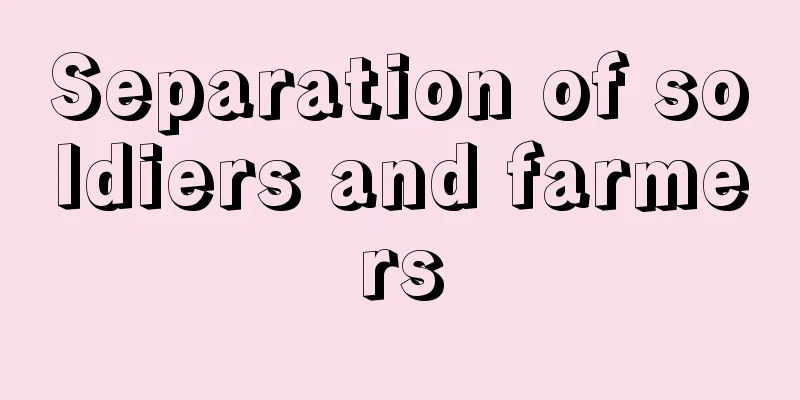Separation of soldiers and farmers

|
The Taiko Land Survey promoted the basic policy of class system and class rule in the early modern period. Before the Taiko Land Survey, samurai had their base in rural areas, directly controlled individual peasants, and were involved in agricultural production. Furthermore, peasants could also become samurai through overthrowing the ruling class, so soldiers and farmers were not separate. The Taiko Land Survey severed this relationship and reorganized the relationship between samurai and peasants as follows: First, samurai were not directly involved in agricultural production itself, and individual samurai did not control individual peasants. Second, samurai left rural areas and lived in castle towns, uniting as the ruling class, extracting rent from peasants for their products, mainly rice, through extra-economic coercion such as the joint liability system (the rice tax system). Thirdly, the daimyo who collected rice tax (land rent) would convert it into cash through merchants to purchase necessities and cover the maintenance costs of their vassals. The entire system described above is called the separation of soldiers and farmers. Next, looking at the process by which the separation of soldiers and farmers was implemented, the separation was institutionalized through the dissolution of the somura (common villages) and local feudal lord system in Kinai and Kinki. In Kinai and Kinki, the hand-managed land of small feudal lords, known as otona-byakusho (farmers), influential village headmen, and jizamurai (local samurai), based on the advanced production capabilities, decreased, and instead, contracted land management based on the independence of ordinary peasants spread. As a result, the small feudal lords were virtually detached from the production process and became parasitic on small peasant production (becoming kajishi feudal lords). Toyotomi Hideyoshi deprived these small feudal lords of their control over the peasants, incorporated them into his vassals, and established them as samurai. Hideyoshi promoted this method during the nationwide implementation of the Taiko survey of land. In response to this, in Kyushu and Tohoku, local feudal lords opposed the loss of their privileges to rule over the peasants, and sometimes even led their subordinate peasants in uprisings. Hideyoshi put down these rebellions, and in 1588 (Tensho 16) issued the Sword Hunt Order, forbidding peasants from possessing weapons and forcing them to focus on farming. Thus, the samurai and farmers, artisans, and merchants classes were separated, and movement between classes was prohibited. At the same time, Hideyoshi forced the feudal lords' territories to create samurai groups that could withstand long-term, drawn-out battles and were separated into soldiers and farmers, through his wars for national unification and invasion of Korea. [Kitajima Manji] "A Study of the History of the Establishment of the Shogunate and Domain Systems" by Keiji Yamaguchi (1974, Akura Shobo) [Reference item] |Source: Shogakukan Encyclopedia Nipponica About Encyclopedia Nipponica Information | Legend |
|
太閤(たいこう)検地によって推進された近世における身分制度と階級支配の基本政策。太閤検地以前、武士は農村に根拠地を置き、個々の農民を直接支配し、農業生産にも関与していた。また、農民も下剋上(げこくじょう)を通じて武士化することもあり、兵農は未分離であった。太閤検地はこの関係を断ち、武士と農民の関係を次のように整理した。第一に、武士は農業生産そのものに直接かかわることなく、個々の武士が個々の農民を個別的に支配することはしない。第二に、武士は農村から離れて城下町に集住し、支配階級としてまとまり、農民から連帯責任制などの経済外強制を通じて、米を中心とした生産物地代を搾取する(米納(べいのう)年貢制)。第三に、年貢米(生産物地代)を取り立てた大名は商人を通じてそれを換金し、必需物資を購入したり、家臣団の維持費を捻出(ねんしゅつ)する。以上の体制全体を兵農分離という。 次に兵農分離が貫徹される過程をみると、兵農分離は畿内(きない)・近国における惣村(そうむら)や在地領主制の解体によって体制化された。畿内・近国では、生産諸力の先進性を基礎とし、長百姓(おとなびゃくしょう)、有力名主(みょうしゅ)、地侍(じざむらい)などとよばれる小領主層の手作(てづくり)経営地が縮小し、それにかわって、平(ひら)百姓の自立化に基づく請作経営地が広まった。これにより、小領主層は、事実上生産過程から遊離し、小農生産に寄生するようになる(加地子(かじし)領主化)。豊臣(とよとみ)秀吉はこれら小領主層の農民支配権を奪い、彼らを家臣団に組み入れ、武士身分として確定した。この方式を秀吉は太閤検地の全国的施行のなかで推し進めた。これに対し、九州や東北では、在地領主層が農民支配の特権を奪われることに反対し、配下の農民まで率いて一揆(いっき)を起こすこともあった。秀吉はこれを鎮圧するとともに、1588年(天正16)刀狩(かたながり)令を出し、農民の武器所持を禁じ、農民は農業に専念すべきものとした。かくて武士と農工商身分は分離され、身分間の移動は禁止されることとなった。それとともに秀吉は、国内統一戦争と朝鮮侵略を通じ、長期長途の戦いに耐えうる兵農分離した武士団の創出を諸大名の領国に強制した。 [北島万次] 『山口啓二著『幕藩制成立史の研究』(1974・校倉書房)』 [参照項目] |出典 小学館 日本大百科全書(ニッポニカ)日本大百科全書(ニッポニカ)について 情報 | 凡例 |
>>: Masanobu Hirauchi - Masanobu Hirauchi
Recommend
"The Indian Way"
…Born in Campo de la Cruz, a small village in the...
Ajime no sahou (The manners of Achi women)
A song with spell-like lyrics that is recited befo...
Dollar - Doru (English spelling) dollar
As of the end of 2008, a total of 29 countries, i...
《Die Juraformation Englands, Frankreichs und des südwestlichen Deutschlands》 (English notation) Die Juraformation Englands Frankreichsunddessudwestlichen Deutschlands
…Professor at the University of Munich (1861-65)....
Money - Kahei (English spelling) money English
Modern capitalist economy is based on the divisio...
white magic
…Originally, it was a type of magic practiced amo...
Aunis
Aquitaine is a region in southwestern France, mai...
Educational expenses
The term "expenses required for educational ...
Campoidea larvae - Campoidea larvae
...General term for insects belonging to the Camp...
Augustana
…However, they are thought to form the core of th...
Shingen Embankment
This embankment is located in Kai City, in the we...
Tomoe - Ha
[Kanji for personal names] [Sound] Ha (Wu) (Han) [...
Ostraciontidae
…A general term for marine fish of the Ostraciont...
Mamichajinai (grey-headed thrush)
A passerine bird of the family Flycatcher. Total l...
Okinawa Reversion Movement
The Ryukyu Islands were separated from Japan and ...









